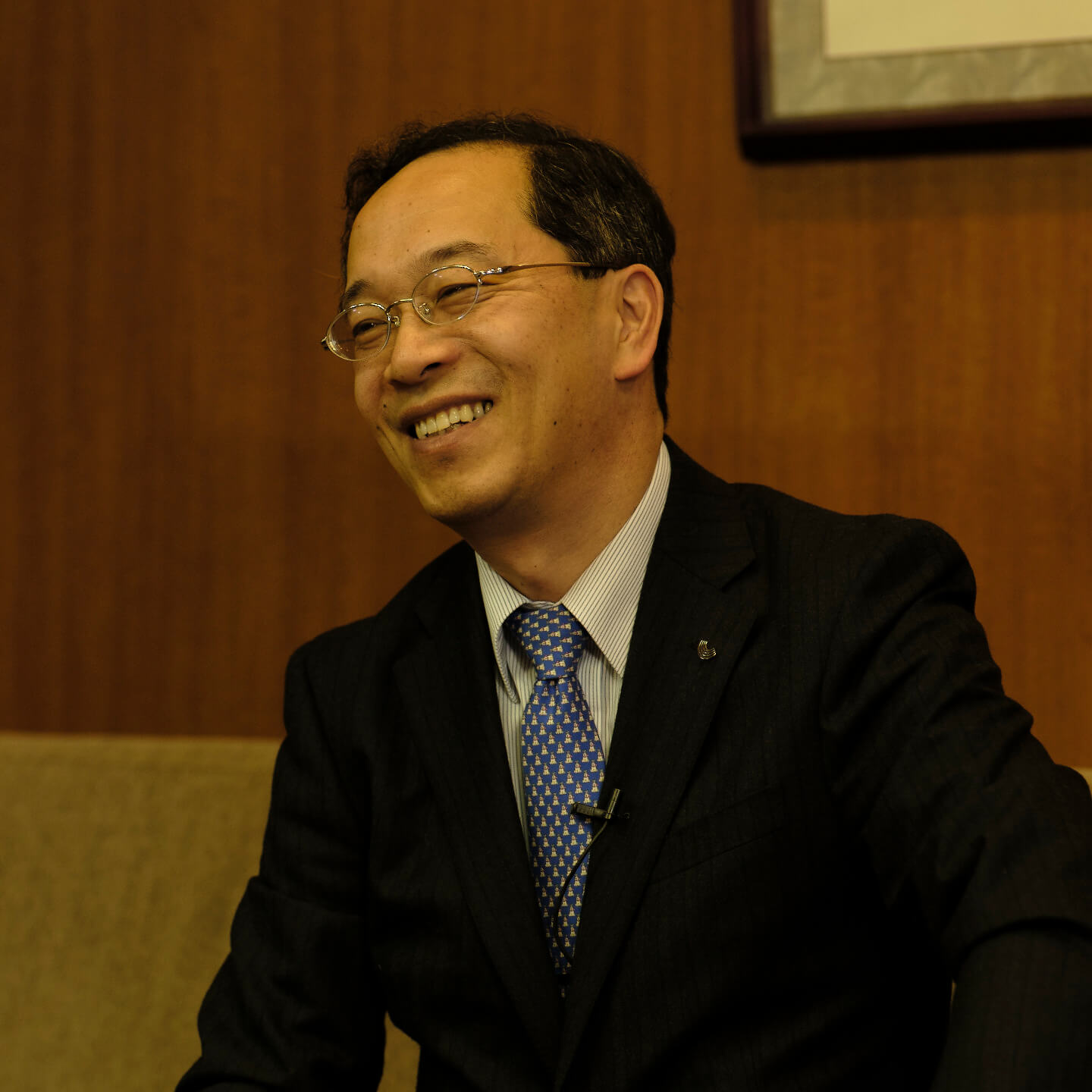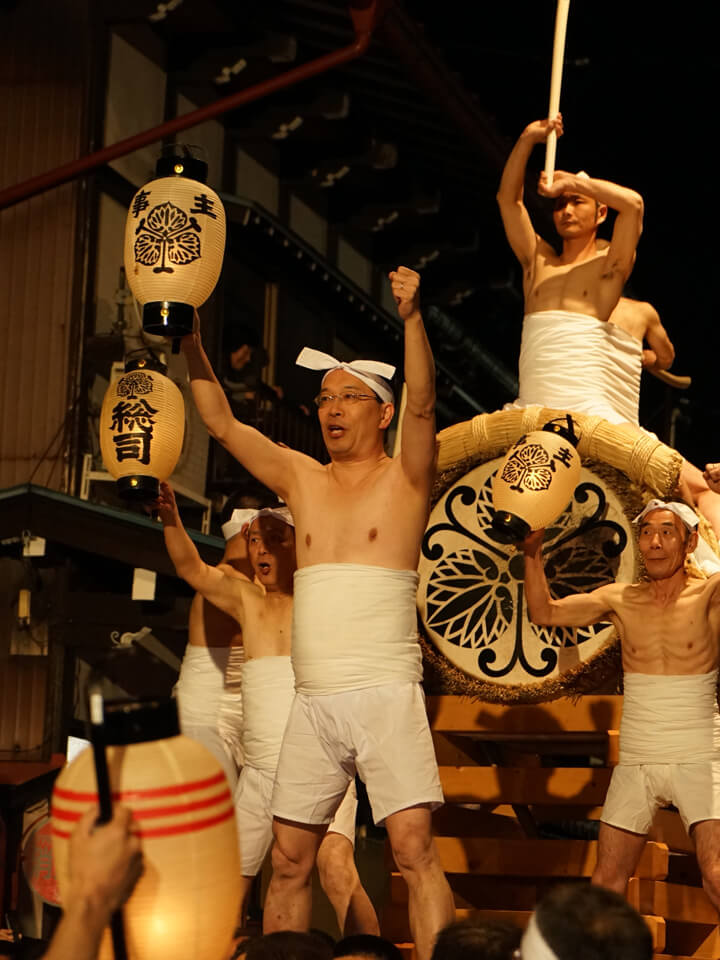Journal Vol.1
Junya Tsuzuku (Mayor of Hida City)
On the days of the festival, I am reminded of the hierarchy of the town with the mikoshi (portable shrine) at the top.
PR video of the Furukawa Festival. Staring at the way ahead at the forefront of a group of half-naked men clad in sarashi white cloth guarding the Okoshi-Daiko (rousing drum), holding a lantern in his hand and wearing a white nejiri hachimaki (twisted headband) around his head, is Mr. Junya Tsuzuku, the mayor of Hida City. You can see that all ujiko (shrine parishioners), regardless of title or age, are joining their hearts to carry out the Shinto ritual.
At the Shigakusai on April 19, you can see rows of mikoshi guards wearing traditional crest-bearing, hakama divided skirts, and vests and you can hear the sound of gagaku court music. At the tail of the procession coming from the shrine is the mikoshi. Seeing this makes me feel a sense of solemnity as it reminds me of the hierarchy of this town with the mikoshi at the top. This is a scene of the traditional Shinto rituals of the Furukawa Festival, one that remains unchanged from a long time ago. The Furukawa Festival is often described as being composed of a tranquil celebration with the mikoshi procession and yatai floats and a dynamic celebration with the Okoshi-Daiko procession. Precisely speaking, however, the yatai and Okoshi-Daiko events are offerings from parishioners to the deity, not Shinto rituals conducted by the shrine.
Putting the mikoshi aside, tracing the history of the yatai and Okoshi-Daiko processions reveals how the Furukawa Festival has changed over time.
The earliest known reference to yatai in literature came in 1782 during the mid-Edo period, the first appearance of the Okoshi-Daiko is in 1831. However, it is from the middle of the Taisho period (1912–1926) to the early years of the Showa period (1926–1989) that the Okoshi-Daiko evolved into what it is today. The performance of karakuri ningyo (mechanical marionettes) was revived in the 1970s after years of suspension, while children’s Kabuki began in the 1980s. The system of wakasha, a team of young men above high school age within each Taigumi (yatai group), was established around 1998. Yatai floats have evolved into what they look like today after a series of renovations and improvements with more and more ornaments added in the postwar period.
Why have they changed? That is because parishioners have a “desire to improve, rather than just preserve, things they have inherited from old times.”
The revival of children’s Kabuki was a result of the discovery of old records and based on limited information therein. The records, found in the course of overhauling a yatai float, show that theatrical performances had been staged on yatai floats from the Edo period (1603–1868) to the early years of the Meiji period (1868–1912). Some neighborhoods have renewed the costumes worn by yatai pullers.

Schedules for the two-day festival have also changed over time. For instance, the Okoshi-Daiko procession used to be held from past midnight on April 19, the day of the Shigakusai, to 4:00 a.m. on April 20 before 1970. The drum-beating procession continued until early morning because it is an event meant to wake up townspeople and signal the start of the Hongakusai, the main festival. However, the schedule was changed in consideration of convenience for tourists, with the starting time moved up to 10:00 p.m. on April 19 and the ending time to 2:00 a.m. on April 20. In 1998, it was further changed to start at 8:00 p.m. on April 19 and end at 00:30 a.m. on April 20.
This led to time constraints for events held on the night of April 19, and it was decided that the night procession of yatai floats with lanterns, which used to be held on the night of April 19, should be held on the night of April 20. However, some people are opposed to this change, saying that it is meaningless to hold the procession, which is an offering to the deity, after the mikoshi returns to the shrine, or that the procession should be held on April 19 for the sake of convenience to tourists. As such, the debate is still continuing today.
Let’s make it better, livelier, and merrier… So, let’s discuss and if a new idea is better, let’s make a change for the better, and keep on doing this. Such is the spirit shared by all parishioners. Since the essential feature of the Furukawa Festival lies in its ever-changing nature, we would like to continue changing in line with changing times.
Text by Minako Hoshikawa / Photo by Naoto Hayasaka [Y’s C]

Photo by courtesy of Hida City
Although attention tends to be focused on the Okoshi-Daiko, a very unique and unusual event, it represents only one third of the Furukawa Festival. The mikoshi procession and yatai parades held in the afternoon of April 19 together constitute the Shigakusai, while the Okoshi-Daiko event takes place at night. The main festival day is April 20. Yatai floats are pulled around and the mikoshi returns to the shrine in the early evening. This is followed by a night festival featuring a parade of yatai floats. The mikoshi, yatai floats, and the Okoshi-Daiko are the three features of the Furukawa Festival. Please come and see all of them.
Large crowds of spectators are expected to turn out for the Okoshi-Daiko event. Volunteer firefighters serve as guards but there occasionally occur cases where spectators get dragged into the waves of Yose-daiko (small drum) bearers rushing to attack the Okoshi-Daiko, the main drum. If that happens, push back. People move forward when pushed from behind. Take that moment to pull yourself out. Falling is extremely dangerous. So, be extra careful not to fall. Also, please be prepared for cold weather as we have many chilly days in April here in Hida Furukawa.
It depends on the year, but tourists may have a chance to participate in the Furukawa Festival.
The Okoshi-Daiko procession is led by a fantastical pageant of beautifully illuminated chochin paper lanterns with Takahari-chochin lanterns carried on long poles and Maruko-chochin lanterns held by hands.
You can join the locals in this lantern procession to walk around the town of Furukawa, holding a Maruko-chochin lantern in your hand.
There are not many restaurants in the town of Furukawa, and we often hear people complain about having trouble finding a place to dine at during the festival as all the restaurants were full. Since we have some restaurants offering local specialties such as Hida beef dishes and pickles omelets, we would definitely like you to try and savor them. It is highly advisable that you reserve a table in advance.
[Restaurants in Furukawa] * New window opens
Hida Gourmet Guide